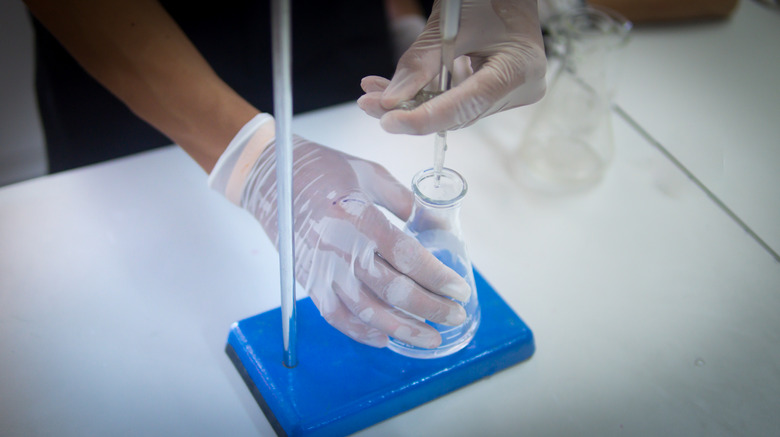How To Do Titration Calculations
A titration is a technique used to work out the concentration of an unknown solution based on its chemical reaction with a solution of known concentration. The process usually involves adding the known solution (the titrant) to a known quantity of the unknown solution (the analyte) until the reaction is complete. To calculate the concentration of the analyte, you measure the volume of titrant used.
Things Needed
- Titrant
- Analyte
- Erlenmeyer flask
- Burette
- Acid-base indicator
- Calculator
1. Prepare the Concentrations
Place the analyte in an Erlenmeyer flask (a conical flat-bottomed laboratory flask with a narrow neck). Place the titrant in a burette (a graduated glass tube with a tap at one end).
2. Mix the Concentrations
Add the titrant to the analyte until the endpoint is reached. This is often indicated by a color change, for example by adding a few drop of phenolphthalein, a commonly used acid‑base indicator, which changes from pink in alkali to colorless in acid.
3. Calculate the Molarity
Use the titration formula. If the titrant and analyte have a 1:1 mole ratio, the formula is molarity (M) of the acid x volume (V) of the acid = molarity (M) of the base x volume (V) of the base. (Molarity is the concentration of a solution expressed as the number of moles of solute per litre of solution.)
If the ratio is not 1:1, use a modified version of the formula. For example, if 35 ml of 1.25 M hydrochloric acid (HCI) is needed to titrate a 25 ml solution of sodium hydroxide (NaOH) to the equivalence point, you can work out the concentration of NaOH using the 1:1 ratio formula, because hydrochloric acid and sodium hydroxide have a 1:1 mole ratio (one mole of HCl reacts with one mole of NaOH).
Multiply the molarity of the acid by the volume of the acid (1.25 x 35). Then take this answer (43.75) and divide it by the volume of the base (25). The answer is 1.75 M, which is the molarity of the base.
TL;DR (Too Long; Didn't Read)
A titration calculation is a simple formula used to work out the concentration (in moles) of one of the reactants in a titration using the concentration of the other reactant. Titrations are usually carried out on acid-alkali reactions, to determine what volumes of the acid and alkali are required to create a neutral solution. They may involve a strong acid with a strong base, a weak acid with a strong base, or a strong acid with a weak base.
Cite This Article
MLA
Gillespie, Claire. "How To Do Titration Calculations" sciencing.com, https://www.sciencing.com/calculate-titration-5328453/. 11 April 2018.
APA
Gillespie, Claire. (2018, April 11). How To Do Titration Calculations. sciencing.com. Retrieved from https://www.sciencing.com/calculate-titration-5328453/
Chicago
Gillespie, Claire. How To Do Titration Calculations last modified August 30, 2022. https://www.sciencing.com/calculate-titration-5328453/
